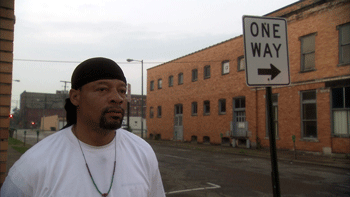Mentally ill and out of prison—a bad combination for those heading back into the community. Just how bad becomes apparent in the forthcoming presentation on Frontline, “The Released,” airing on April 28 on PBS. (See local listings for time.) It takes the viewer into the lives of several ex-prisoners and follows them through their grim cycle of prison, release and re-incarceration. Their medication gone, with little in the way of supportive services, and already damaged by drug and alcohol abuse, most live a twilight existence. They pass in and out of jails, prisons, homeless shelters, group homes and mental hospitals, ending back on the streets of various Ohio cities.
Although the filmmakers focus on Ohio, the same situation exists throughout the nation. Seven hundred thousand people leave the nation’s correctional institutions every year, and roughly half are mentally ill. In their earlier film, the 2005 “The New Asylums,” the filmmakers Karen O’Connor and Miri Navasky profiled mentally prisoners in the Ohio prison system. “The Released” is the next chapter in that story.
The title is ironic: the men in the film leave prison physically free, but their mental illness keeps them as enchained as if they were still behind bars. In secure settings where they receive appropriate medication, these men seem like normal human beings. Once on the streets, however, their fortunes turn. Typically set free with little more than their two weeks worth of medication, $75 and a bus ticket, the majority are back behind bars in three months.
One episode shows a middle-aged woman excitedly calling 911 to report a man trying to breaking into her house. "Please hurry,” she pleads. The police respond quickly and arrest a very delusional man named Lynne Moore, a paranoid schizophrenic who believed that Osama Bin Laden was in the woman’s house. Moore had previously been arrested and released over 20 times. This was his fourth time in prison.
With one exception, the men in the film are poorly educated African Americans like Moore. The sole white man in the film is a 29-year-old apparently from a middle class background. Yet like the others, he lacks the kind of supportive family that might have been able to assist him. We see him arrested and, after he becomes violent, placed in four-point restraints by correctional officers. Adding to his problems is a long history of refusing medication. And yet, as he himself says, when he takes Clorazil, "I’m able to function, abide by rules set here." With better luck than most, he stabilizes once he takes up residence in Bridgeview Manor, in Astabula, with 15 other schizophrenic men. It is the only residential facility in Ohio, we are told, that accepts and treats indigent mentally ill people.
Although the resources to help mentally ill people on their release from prison are shockingly few, a few organizations do exist for that purpose. In addition to Bridgeview, there is the Refuge of Hope, a homeless shelter in Canton that accepts mentally ill residents. The director of the center says that their residents have "broken down every relationship they’ve had, whether family or friends, so there’s ...no other place to catch them" except here. Facing terrible odds, he and his staff do their best.
Another effort at providing basic help in Ohio involves a mobile van. We listen to a young doctor speaking about the unrealistic assumptions placed on the mentally ill clients. A nurse who works on the van speaks with one of the men profiled in the film. She is holding the small plastic box marked with the days of the week for holding his medications. She asks why the medications are still in their slots for the three previous days. He is unable to answer. The untaken medications speak for themselves.
Much of the problem depicted in the film goes back to the closing of psychiatric hospitals around the country in the l970s. The closings were based on the assumption that mentally ill people could receive adequate help in their own communities. While the concept was worthwhile, funding was in short supply. A former official from Ohio’s Department of Corrections does not say that state psychiatric hospitals should return to their former size and scope, but makes it clear that nothing is now taking their place. The one hospital featured in the film, Northcoast, a facility in Toledo, provides only short-term crisis care for the few who are there. The same is true of other psychiatric hospitals.
Although Frontline focuses on men in this film, viewers may well wonder what is the fate of mentally ill women prisoners. Even more so than with male prisoners, the backgrounds of many incarcerated women include early physical and sexual abuse that results in deep mental problems, and treatment options are minimal.
The situation in another Midwestern state, Wisconsin, offers an example. Early in 1990, the U.S. Justice Department cited its largest women’s prison, the Taycheedah Correctional Institute in Fond du Lac, for violating the prisoners’ constitutional rights. A task force found that psychiatric and psychology staffing failed to meet national standards. Correctional officers, for instance, rather than health care staff, were dispensing medications.
Perhaps Frontline will some day do a needed documentary on mental illness among female prisoners and their lives after release. But its current look at mentally ill prisoners released back into Ohio’s communities is an eye opener. It underscores the serious shortcomings of this aspect of the U.S. criminal justice system, seen through the lens of one state that mirrors what happens in others.






